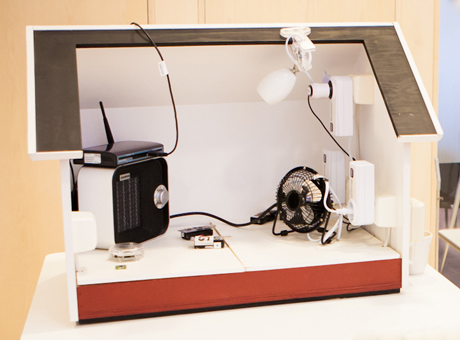Joel Höglund and Stamatis Karnouskos
The future of Smart Grids lies in standardization and open protocols. By using the capabilities of modern smart meters, which communicate over wireless radio, grid power quality monitoring can be improved while keeping costs low.
In NOBEL we have been developing middleware and services for the future smart electricity grids. One of the key issues, in the context of lower level networking, is how best to make use of the more fine grained smart meter measurement data. We have studied how smart meter data can be used to complement and partially replace more expensive grid monitoring equipment without comprising on power quality monitoring [1]. This is achieved using smart meters that communicate over low power radio, with the smart meters forming a wireless sensor network (WSN).
The European Commission FP7 NOBEL (www.ict-nobel.eu) project‘s partners include: SICS from Sweden, University of Duisburg-Essen and SAP from Germany, ETRA and Alginet from Spain and CERTH from Greece.
Part of the work has been to explore and outline the business advantages that can be gained by improved power quality monitoring [1]. Improved monitoring gives electricity providers proof of power quality that can be delivered to residential users and be used to attract new customers. It would allow residential customers to monitor their own power quality. It offers greater potential for early problem identification and preventive maintenance. Finally, it could enable electricity providers to better optimize the voltage delivered, which may lead to a reduction of the energy consumed of up to 4% [1] (for Sweden that would correspond to 5.6 TWh in 2011).
The next generation WSN based tests have been performed at a distributed testbed at SICS, Stockholm, Sweden, with the receiving enterprise services running at UDE in Duisburg. Larger scale user trials using several energy services have been performed while tapping into the existing smart meter infrastructure in Alginet, a small town outside of Valencia, Spain. In the lab tests, the smart meters are modelled with relatively cheap, low power, hardware. As an important partial goal is to reduce the overall consumption, new infrastructure should not offset the savings by its own energy consumption.
By being based on the Contiki operating system [2], the smart meter middleware is using implementations of the wireless standards which have gone through interoperability testing across different platforms. Contiki is being supported by a growing number of hardware platforms, and has an active developer community. Using the latest routing standard for wireless networks, RPL, the smart meter network becomes self-configuring. A newly installed device will automatically connect with the rest of the network, and acquire the needed network configuration data. This lowers installation costs, and makes it easy to add new meters.
Based on local voltage deviation detections, smart meters can trigger events to alert the local grid operator. The events could either trigger a request to automatically increase the sampling rate in the affected area, or be forwarded to a grid operator for manual decision making.
As the radio packet sizes in WSNs are smaller than on the wired internet, fragmentation and address compression become important issues. This is handled by a 6LoWPAN layer which ensures the maximum packet proportions can be used for actual program data. Still, it is worth spending some design effort to keep messages – meter readings – short so as to limit the delays of fragmentation which would increase network delays.

High power quality, an important requirement for the smart homes with a high number of connected appliances.
In our evaluations we have shown that the testbed could handle meters reporting data every 60 seconds. On top of that we made extra subscriptions when the system detected a voltage deviation, where a subset of the meters started reporting every 10 seconds to aid the tracing of quality problem origins. These results were communicated to an enterprise system via the NOBEL energy services and show that the suggested architecture is feasible with acceptable overhead [1]. The power network will continue to need high cost network analysers to get instantaneous state information at critical points in the grid. Nevertheless, there are clear advantages to complementing the architecture with modern smart meters capable of delivering fine grained monitoring data.
The NOBEL project started in spring 2010, and finished in December 2012. Security in the wirless networks has not been addressed within the project, but for real life deployments the customer data needs to be further protected, as access to or tampering of energy data may raise security and privacy concerns. Since the design is standard based, it is well prepared to be extended with IPSec [3], something which we currently investigating.
References:
[1] J. Höglund, D. Ilic, S. Karnouskos, R. Sauter and P. Goncalves Da Silva: “Using a 6LoWPAN Smart Meter Mesh Network for Event-Driven Monitoring of Power Quality”, in 3rd IEEE International Conference on Smart Grid Communications (SmartGridComm), Tainan City, Taiwan, 2012
[2] A. Dunkels, B. Grönvall, and T. Voigt: “Contiki - a lightweight and flexible operating system for tiny networked sensors”, 1st IEEE Workshop on Networked Embedded Sensors (EmNetS-I), Tampa, Florida, USA, November 2004
[3] S. Raza, S. Duquennoy, T. Chung, D. Yazar, T. Voigt, and U. Roedig: “Securing Communication in 6LoWPAN with Compressed IPsec”, IEEE International Conference on Distributed Computing in Sensor Systems (DCOSS '11), 27-29 June 2011, Barcelona, Spain.
Please contact:
Joel Höglund, SICS
Tel: +46 70 775 16 09
E-mail:











